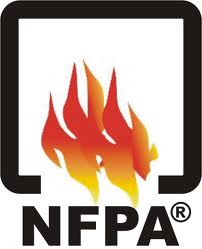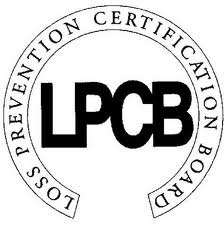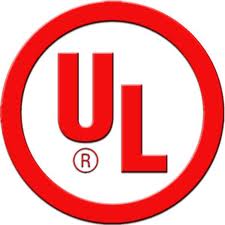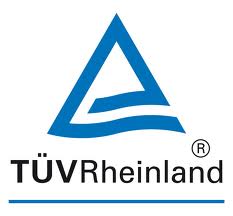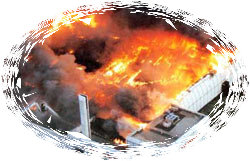
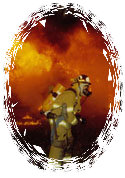


Fire Prevention > Means of Egress
Separation of Means of Egress
Means of egress shall provide protection along path of travel. Where an exit is required in this part to be separated from other parts of the building, as follows:
The separating construction shall meet the following requirements:
The separation has at least a 1-hr fire resistance rating where the exit connects three stories or less. This applies whether the stories counted are above or below the story where exit discharge begins.
The separation has at least a 2-hr fire resistance rating where the exit connects four or more stories, whether the stories counted are above or below the story where exit discharge begins.
Headroom:
Means of egress shall be designed and maintained to provide headroom to be not less than (2.25) m with projections from the ceiling at least (2) m nominal height above the finished floor. Headroom on stairs shall be a minimum of (2) m, and shall be measured vertically above a plane parallel to and tangent with the most forward projection of the stair tread.
Capacity of Means of Egress
Occupant Load:
The total capacity of the means of egress for any story, balcony, or other occupied space shall be sufficient for the occupant load thereof.
Occupant load for design purposes shall be specified as required by table (1).
For multi story buildings, capacity of the exits shall be computed by considering occupant load for each story individually, or for occupant load of any upper floors using same exits. This means, the capacity of evacuation floor shall not be equivalent to sum of exit capacities of other floors, but it shall be equal the largest capacity of any floors using that exit.
Where means of egress from stories above and below converge at an intermediate story, the capacity of the means of egress from the point of convergence shall be at least the sum of the two.
Units of Egress Capacity:
Exit capacity units shall measure egress capacity. Exit capacity unit is (0.55)m. Exit width is computed by dividing it is net width by (0.55) m, if fraction is less than (0.5), it shall be neglected, while, if fraction is more than (0.5), it shall be computed as half unit of exit capacity.
Width of means of egress shall be measured in the clear at the narrowest point of the exit component under consideration. Handrail allowed to part of the width of means of egress if width of means of egress is less than (0.9) m.
Capacity of Units of Egress Capacity:
Capacity of unit of egress capacity shall be specified by number of persons whom could pass through at certain period of time. Capacity of unit depend upon type of exit passageway as follows and according to means of egress classification as mentioned at Section (Minimum Width):
*Class A Ramps |
(100) persons in any movement of the two directions. |
|
*Class B Ramps: |
(60) persons in ascending direction (100) Persons in descending direction |
|
*Staircases: |
(60) persons in either ascending, or descending directions. |
Table (1) Occupant Load Factors |
||||||||||||||||||||||||||||||||||||||||||||||||
|
||||||||||||||||||||||||||||||||||||||||||||||||
Minimum Width:
The minimum width of any means of egress shall be that required for each occupancy as specified in general requirements, but it shall be at least (70) cm.
The exit width shall not be less than exit path width.
Doors:
In general, for fire prevention purposes, doors are three types:
Normal doors
Fire rated doors: Doors classified as fire doors shall be fire resistance doors specified by testing door with it's frame according to American Standard (E152-ASTM), American Standard (NFPA-252), British Standard (B.S 476:Part 8), or British Standard (B.S 459:Part 3).
Smoke sealed doors
Applications:
Every door and every principal entrance that is required to serve as an exit shall be designed and constructed so that the way of egress travel is obvious and direct. Windows that, because of their physical configuration or design and the materials used in their construction, have the potential to be mistaken for doors shall be made inaccessible to the occupants by barriers or railings.
Exit capacity units:
Exit capacity units for doors are specified by opening net width.
Exit capacity units for exit sub-divided by columns are specified by sum of each part capacity individually.
Door width and floor level
Door openings in means of egress shall be at least (70) cm in clear width, and not more than (1.2)m.
The elevation of the floor surfaces on both sides of a door shall be similar. The elevation shall be maintained on both sides of the doorway for a distance at least equal to the width of the widest leaf. Where the door discharges to the outside, the floor level outside the door shall be permitted to be one step lower than the inside, but not more than (20) cm lower.
Power-Operated Doors:
Doors shall swing in the direction of egress travel where used in staircases.
Door providing access to a stair shall maintain an unobstructed width of a stair or landing of at least (50) cm and, when fully open, efficient width of a stair or landing shall not be reduced.
During its swing, any door in a means of egress shall leave unobstructed at least one half of the required width of an aisle, or corridor.
Sided hinged (swinging) doors in exit access serving an occupant load of more than (50) persons, or at high hazard contents occupancy shall be opened in the direction of travel.
The opening force for doors shall not be more than (225) N applied to the latch stile.
Door accessories:
Locks, Latches, and Alarm Devices:
Doors shall be arranged to be opened readily from the egress side whenever the building is occupied. Locks, if provided, shall not require the use of a key for operation from the inside of the building.
Fire exit doors hardware:
Where a door is required by safety requirements to be equipped with panic or fire exit hardware, such releasing device shall not need more than (65) N to applied to open.
Consist of bars or panels, the actuating portion of which extends across at least one half of the width of the door leaf, at least (75) cm and not more than (110) cm above the floor.
Required panic hardware and fire exit hardware shall not be equipped with any arrangement that prevents the release of the latch when pressure is applied to the releasing device.
Only approved panic hardware used for doors shall be approved by authority having jurisdiction.
Self-Closing Devices:
A door designed to normally be kept closed in a means of egress shall be a self-closing door and shall not be secured in the open position at any time.
In any building of low or ordinary hazard contents, or where approved by the authority having jurisdiction, doors shall be permitted to be automatic-closing Upon release of the hold-open mechanism, the door becomes self-closing in case of fire, under following conditions:
Upon release of the hold-open mechanism, the door becomes self-closing.
The release device is designed so that the door instantly releases manually.
The automatic releasing mechanism is activated by the operation of an approved, automatic smoke detection system or automatic sprinkler system installed to protect the entire building. The operation of approved smoke detectors or automatic sprinklers installed in such a way as to detect smoke or heat on either side of the door opening.
Any fire detection system by smoke detectors, or automatic sprinklers is provided with such supervision and safeguards as are necessary to ensure reliability of operation in case of fire according to authority having jurisdiction approval.
Power-Operated Doors:
Definition:
Power-Operated Doors are doors operated by actuation of photo-cell device upon the approach of a person.
Design:
The design shall be such that in the event of power failure, the door opens manually.
Use:
Power-operated doors are permitted to be used as exit, or at egress travel incase doors can be opened in the same travel direction.
Existing Doors :
The use of wood core doors as fire doors is allowable, this applied for door thickness not less than (38) mm, provided door fire side or both sides shall be provided with asbestos board(s) with a thickness to be not less than (4.5) mm, and the door is perfectly installed.
Interior Stairs:
General:
Interior stairs are classified to two classes as shown in table (2).
Class A |
Class B |
|
Minimum width clear of all obstructions, except projections not more than (90) mm and where occupant load is fewer than (50) |
(110) cm |
(90) cm |
Minimum width clear of all obstructions, except projections not more than (90) mm and where occupant load is equal or more than (50) |
(110) cm |
(110) cm |
Maximum height of risers |
(19) cm |
(20) cm |
Minimum tread depth |
(25) cm |
(22) cm |
Minimum headroom |
(225) cm |
(225) cm |
Maximum height between landings |
(3.6) m |
(3.6) m |
Minimum width of landing in direction of travel |
(110) cm |
(110) cm |
Minimum door width directly open to stair without landing |
not permitted |
not permitted |
Enclosure of stairs:
All interior stairs shall be enclosed in accordance with clause (1) of this part.
Stair Details:
Each stair used in buildings more than three stories in height shall be of noncombustible material, except handrails.
Areas within stairs used as means of egress shall not be permitted to be used for any purposes that obstruct occupants' evacuation.
Each stair, platform, and landing shall be designed to serve expected life loads.
Stairs and intermediate landings shall continue with no decrease in width along the direction of egress travel.
Stair treads and landings shall be uniformly slip resistant.
Spiral stairs are not permitted.
Riser and tread dimensions shall be selected in which the twice height of riser in addition to tread dimension (without including tread nosing edge) shall not be less than (55) cm, and not more than (70) cm. There shall be no variation more than (5) mm in the depth of adjacent treads or in the height of adjacent risers.
Risers for each stair shall not be less than three, and be more than twelve.
Tread having dimension less than (25) cm shall has (25) mm nose length.
Signs with directional indicators indicating the direction to the level of exit discharge at public way shall be provided for stairs serving basement floors.
Guards and Handrails:
Means of egress that are sited in parallel to unprotected floor slaps shall be provided with guards to prevent falls over the open side. Each stair and ramp of class B shall be provided with guards at each side.
Stairs shall have handrails. Required handrails shall continue for the full length of each flight of stairs.
There shall be no projections of handrail supports that might engage loose clothing.
Handrail Details:
Handrails on stairs shall be at least (75) cm and not more than (85) cm above the surface of the tread, measured vertically to the top of the rail from the leading edge of the tread.
New handrails shall provide a clearance of at least (4) cm between the handrail and the wall to which it is fastened.
Handrails shall be designed to resist a vertical and horizontal load equivalent to (1) KN.
Stairs having width more than (2.2) m shall be provided with intermediate handrail(s) in which the distance between each two handrails shall exceed (2.2) m.
Guard Details:
The height of guards shall be measured vertically to the top of the guard from the surface adjacent thereto.
Guards shall be at least (105) cm high.
Open guards shall have intermediate rails as following:
The clear distance between intermediate rails, floor level, riser, and stone edges shall not exceed (15) cm.
Grills with a maximum horizontal distance of (15) cm between each.
Decorative metal construction.
Stone or block walls.
Any combination from above, or any other suitable materials.
Guard of any type shall be designed to resist a vertical force not less than (1.2) KN/m 2 that affect total area of the guard including all openings in.
Smoke-proof Enclosures:
Smoke-proof Enclosure shall be constructed from a material having 2-hr fire resistance ratings.
Walls isolating enclosure from building inside shall not have any openings. Windows equipped with reinforced glass installed at metal frame for walls separating enclosure from outside shall be permitted.
Smoke-proof enclosure shall be connected to each floor by lobby or balcony opened to atmosphere with a length or width not less than stair door width. Smoke-proof enclosure exit shall leads to street, open yard, or closed yard with a minimum width of (7) m, and a minimum area of (100) m 2 . Balconies shall be provided with protective partitions.
The door leading from building to an open lobby of smoke-proof enclosure shall has a width not less than (90) cm. All doors shall be fire rated and self closing, opened in evacuation direction. If doors provided with openings, it shall be isolated by reinforced glass of an area not exceeding (0.45) m 2 .
Horizontal Exits:
General :
Application:
Horizontal exits shall be permitted to be substituted for other exits (stairs, ramps, doors leading outside the building) shall be at least half that required for exit capacity.
Refugees area discharge :
Every fire compartment for which credit is allowed in connection with a horizontal exit shall have, in addition to the horizontal exit or exits, at least one stairway or door way leading outside.
Wherever either side of the horizontal exit is occupied, the doors used in connection with the horizontal exit shall be unlocked from the egress side.
The floor area on either side of a horizontal exit shall be sufficient to hold the occupants of both floor areas, providing at least (0.3) m 2 clear floor area per person.
Walls for horizontal exits :
Fire barriers separating buildings or areas between which there are horizontal exits shall have a 2-hr fire resistance rating.
Vertical openings between the story with the horizontal exit and the open fire area story are enclosed with construction prevents spread of smoke or fire through, either opening is horizontal exit, or not.
Where swinging fire doors are used in horizontal exits, they shall swing in the direction of egress travel, and where a horizontal exit serves areas on both sides of a fire barrier, there are adjacent openings with swinging doors, opening in opposite directions, with signs on each side of the fire barrier indicating the door that swings with the travel from that side.
Sliding doors are not permitted to be used at horizontal exits.
Bridges and Balconies :
Each bridge or balcony utilized in conjunction with horizontal exits shall have guards and handrails.
Every bridge or balcony shall be at least as wide as the door leading to it and at least (1.1) m wide for new construction.
Where the bridge or balcony serves as a horizontal exit in one direction, the door shall be required to swing only in the direction of egress travel.
Where the bridge or balcony serves as a horizontal exit in both directions, doors shall be provided in pairs, swinging in opposite directions. Only the door swinging in the direction of egress travel shall be counted in determination of egress capacity.
The bridge or balcony floor shall be approximately level with the building floor, or at not more than (20) cm below the level of the inside floor.
Ramps shall be used to connect two different floor levels. If level difference exceeds (0.5) m, a stair shall be used.
All wall openings, in both of the connected buildings or fire areas, any part of which is within (3) m of any bridge or balcony as measured horizontally or below, shall be protected with fire doors or fixed reinforced glass windows installed at metal frames.
Exterior Stairs:
General :
All exterior stairs serving as exit component shall comply with interior stairs requirements.
Exterior stairs separation:
Exterior stairs shall be separated from the interior of the building by walls with the fire resistance rating required for interior stairs. Opening shall be protected with fire doors or fixed reinforced glass windows installed at metal frames.
Buildings consisting of (3) floor or less could not be complied with requirements of this clause in case other far and separate exit is available.
Each opening of building having (4) floors or more shall be protected with approved fire door or fire window assemblies to prevent fire and smoke spread. The opening or any portion of the opening is located as follows:
If within (4.5) m measured horizontally of any balcony, platform, or stairway constituting a component of the fire escape stair.
If within (10.5) m below of any balcony, platform, walkway, or stairway constituting a component of the fire escape stair.
If within (3) m above of any balcony, platform, or walkway as measured vertically.
Any wall facing a court served by a fire escape stair where the least dimension of the court is not greater than one third of the height to the uppermost platform of the fire escape stair measured from the ground.
Exterior stairs serving building of more (3) floors shall be provided with guards and handrails.
Balconies that serve as exit and lead to exterior stair shall have the same level of floor that serve.
Rooms:
Interior Ramps :
Ramps Classes
Ramps are classified into classes A and B as table (3).
|
|||||||||||||||||||||
* Unless stated otherwise.
Interior ramps enclosure:
Cabinets or similar are not allowed to be installed under ramps that used as means of egress. The area under ramp shall not be used for any purposes.
Interior ramps details:
Each ramp and landing shall be designed to serve (5) Kn/m 2 expected uniform life loads.
Landing shall be leveled, any changes in travel direction shall be made only at landings.
A ramp used as a means of egress in a building more than three stories in height shall be of noncombustible material. The ramp floor and landings shall be solid and without perforations.
A ramp shall have a slip resistant surface.
Guards shall be provided for ramps.
Exterior Ramps :
Exterior ramps shall comply with interior ramps requirements
Fire Escape Stairs:
General :
Fire escape stairs shall not be used, and recommended to be used only to substitute lack of fire prevention measures.
Fire escape stairs are restrict used due to it's disadvantages as spread of fire or smoke from lower floors windows before occupants evacuation from upper floors whom using this stairs, accumulation of snow or ice on stairs, and impediments to stair use by persons having a fear of high places which reduce landing speed.
Fire escape stairs shall not constitute more than (50) percent of the required means of egress.
Fire escape stairs shall not constitute any of the required means of egress in new buildings.
Fire escape stairs shall provide a continuous, unobstructed path of travel to an area of refuge. Fire escape stairs shall be permitted to lead to an adjoining roof that is crossed before continuing downward travel. The direction of travel shall be clearly marked. Fire escape stairs shall be permitted to be used in combination with inside stairs complying with fire prevention requirements of interior and fire escape stairs, provided a continuous safe path of travel is maintained.
Protection of Openings :
Fire escape stairs shall be exposed to the smallest possible number of window and door openings. Each opening shall be protected with approved fire door or fire window assemblies where the opening or any portion of the opening is located as follows:
If within (4.5) m measured horizontally of any balcony, platform, or stairway constituting a component of the fire escape stair.
If within (10.5) m below of any balcony, platform, walkway, or stairway constituting a component of the fire escape stair.
If within (3) m above of any balcony, platform, or walkway as measured vertically.
Any wall facing a court served by a fire escape stair where the least dimension of the court is not greater than one third of the height to the uppermost platform of the fire escape stair measured from the ground.
Exit Passageway :
Fire escape stairs shall extend to the roof in all cases where the roof is subject to occupancy or provides an area of safe refuge. In cases fire escape stair does not lead to roof, a fire escape ladder shall be provided for access to the roof.
Balconies that serve as exit and lead fire escape stair shall have the same level of floor that serve.
Access to a fire escape stair shall be directly to a balcony and shall be no higher than the floor by (45) cm below the windowsill level.
Guards and Handrails :
All fire escape stairs shall have walls or guards and handrails on both sides having height not less than (0.75) m, and not more than (1.05) m.
Materials and Strength:
Noncombustible materials shall be used for the construction of balcony and all components of fire escape stairs as iron, steel, and concrete according to the authority having jurisdiction.
Guards and handrails of fire escape stairs and balconies shall be designed to resist a vertical and horizontal forces. If stair is surrounded by construction, the horizontal force effect shall be considered at a height of (1.05) m measured from tread stair or balcony floor.
Exits shall be located and exit access shall be arranged so that exits are readily accessible at all times. Where exits are not immediately accessible from an open floor area, safe and continuous passageways leading directly to every exit shall be maintained and shall be arranged to provide access for each occupant to at least two exits by separate ways of travel, unless stated in this requirements allowing one exit for certain type of occupancies.
Arrangement of Means of Egress
General:
Where more than one exit is required from a building, such exits shall be remotely located from each other and shall be arranged and constructed to minimize the possibility that more than one has the potential to be blocked by any one fire or other emergency condition.
Impediments to Egress:
In no case shall access to an exit be through closets, bedrooms or similar spaces, or other rooms subject to locking.
Exit access and exit doors shall be designed and arranged to be clearly recognizable. Hangings or draperies shall not be placed over exit doors or located to conceal or obscure any exit. Mirrors shall not be placed on exit doors. Mirrors shall not be placed in or adjacent to any exit in such a manner as to confuse the direction of exit.
Extra Hazard Occupancies:
Exit access shall be arranged so that it shall not be necessary to pass through extra hazard occupancy unless exit access is isolated and protected against spread of fire or smoke.
Exterior Ways of Exit Access:
Exit access shall be permitted to be by means of any exterior balcony or roof.
Exit access shall not have any obstructions as railing, barriers, or gates.
Exterior exit access as balcony or roof shall be arranged so that there are no dead ends in excess of (6) m.
An exterior exit access shall have solid, substantially level floors and shall have guards at unenclosed sides.
General:
The maximum travel distance to exit is specified according to following factors:
Number of occupants, ages, health status, and evacuation speed.
Number and type of obstructions to exit, as show platforms, seats, heavy-duty machines, and similar which need turning around to reach exit.
Number of persons at any room, and distance between farthest point at room and the door.
Types and quantities of combustible materials available at certain occupancy.
Flame spread degree that depends upon construction and finishing materials type, isolation degree of part of the building, and availability of fire alarm and fire fighting systems.
The maximum travel distance to exit and the maximum length of dead-ends at passageways for each occupancy according to table (4).
The travel distance to an exit shall be measured on the floor along the centerline of the natural path of travel starting from the most remote point subject to occupancy, curving around any corners or obstructions with a (0.3) m clearance there from, and ending at the center of the doorway or other point at which the exit begins. Where measurement includes stairs, the measurement shall be taken in the plane of the tread nosing.
Travel distance of exit passageway of open areas shall be measured from the occupied most remote point of exit.
For separate rooms having not more than (6) persons, the travel distance of exit passageway shall be measured from room door, taking into consideration, the distance from any point of room to the door shall not exceed (15) m.
Where open stairways or ramps are permitted as a path of travel to required exits, the distance shall include the travel on the stairway or ramp and the travel from the end of the stairway or ramp to an outside door or other exit in addition to the distance traveled to reach the stairway or ramp.
All exits shall terminate directly at a public way or at an exterior exit discharge. Yards, courts, open spaces, or other portions of the exit discharge shall be of required width and size to provide all occupants with a safe access to a public way.
Not more than (50) percent of the required number of exits, and not more than (50) percent of the required egress capacity, shall be permitted to discharge through areas on the level of exit discharge, provided:
Such discharge from upper floors leads to a free and unobstructed way, and such way is readily visible and identifiable from the point of discharge from the exit.
Such discharge point, unobstructed area, and exit shall be at the same level.
The level of discharge and adjacent un-isolated areas are protected throughout by an automatic sprinkler system.
On contrary of clause (3) of this paragraph, building allowed not to be protected by sprinkler system, provided:
The distance from exit to door leads to building outside shall not exceed (7) m.
The foyer shall be separated from the remainder of the level of discharge by construction providing protection at least the equivalent of wired glass in steel frames.
The entire area on the level of discharge shall be separated from areas below by construction having a fire resistance rating not less than 2-hours.
The exit discharge shall be arranged and marked to make clear the direction of egress to a public way. Stairs that continue beyond the level of exit discharge shall be interrupted at the level of exit discharge by partitions, doors, or other effective means to prevent movement to lower floors not leading to building outside.
Where approved by the authority having jurisdiction, exits shall be permitted to be accepted, when discharging to the roof or other sections of the building or adjoining buildings if there is a continuous and safe means of egress from the roof, and the roof has a fire resistance rating at least the equivalent of that required for the exit enclosure.
Illumination of Means of Egress
General :
Illumination of means of egress shall be continuous during the time that the conditions of occupancy require that the means of egress be available for use.
Artificial lighting shall be employed at such places and for such periods of time as required to maintain the illumination to the minimum criteria values herein specified.
The floors and other walking surfaces within an exit including corners, corridors intersection, stairs, landings, and exit doors shall be illuminated to values of at least (10 lux) measured at the floor. In show rooms, theatres, or similar, the illumination of the floors of exit access shall be at least (2 lux) during periods of performances or projections.
Any required illumination shall be arranged so that the failure of any single lighting unit shall not leave any area in darkness.
Sources of Illumination:
Battery-operated electric lights shall not be used for primary illumination of means of egress. Battery-operated electric lights shall be permitted to be used as an emergency source to the extent permitted under clause (10).
Lantern and reflected lights shall not be used as alternative for primary illumination mentioned at this clause.
General :
Emergency lighting facilities for means of egress shall be provided in accordance with this section for every building or structure where required in general requirements.
Performance of System :
Emergency illumination shall be provided for a period of (1) hr. Emergency lighting facilities shall be arranged to provide initial illumination that is at least an average of (10 lux).
Battery-operated emergency lights shall use only reliable types of rechargeable batteries provided with suitable facilities for maintaining them in properly charged condition.
The emergency lighting system shall be arranged to provide the required illumination automatically in the event of any interruption of normal lighting.
General :
Exits shall be marked by an approved sign readily visible from any direction of exit access.
Access to exits shall be marked by approved, readily visible signs in all cases where the exit or way to reach it is not readily apparent to the occupants. This applied for all cases, including occupancies not required such signs.
Every sign shall be located and of such size, distinctive color, and design as to be readily visible and shall provide contrast with decorations, interior finish, or other signs. No decorations, furnishings, or equipment that impairs visibility of an exit sign shall be permitted.
Any brightly illuminated sign (for other than exit purposes), display, or object in or near the line of vision of the required exit sign of such a character as to detract attention from the exit sign shall not be permitted.
Size of Signs:
Externally illuminated signs required by this section shall have the word "EXIT" in Arabic in plainly legible letters.
Illumination of Signs:
Externally illuminated signs shall be illuminated by not less than (50 lux). The sign shall be continuously illuminated as required under the provisions of Section (9).
Where emergency lighting facilities are required, the exit signs shall be illuminated by the emergency lighting facilities.
Specific Requirements:
Directional Signs:
A sign reading "EXIT," with a directional indicator showing the direction of travel shall be placed in every location where the direction of travel to reach the nearest exit is not apparent.
Special Signs:
Any door, passage, or stairway that is neither an exit nor a way of exit access and that is located or arranged so that it is likely to be mistaken for an exit shall be identified by a sign reading "TO BASEMENT, TO STORE, TO LOCKER, or similar.
Any exit door, or door at exit passageway designed to be closed at normal conditions shall be provided with a sign:
FIRE EXIT
KEEP CLOSE
Special Provisions for Occupancies with High Hazard Contents
In all cases where the contents are classified as high hazard, exits of such types and numbers shall be provided and arranged to permit all occupants to escape from the building or structure or from the hazardous area thereof to the outside or to a place of safety with a travel distance of not more than distance indicated at table (4).
Egress capacity shall be specified according to type of occupancy, and to be not less than one unit for each (30) persons if they discharged by interior or exterior stairs. The capacity shall not be less than one unit for each (50) persons if they discharged by doors at ground floor, horizontal exits, or ramps of class A.
At least two means of egress shall be provided from each building or hazardous area thereof.
Halls, corridors, windowless basements, or yards shall not be used as part of means of egress in high hazard occupancies. Means of egress shall be arranged so that there are no dead ends in corridors.
Sources : C.D.D Website
JordanFire.Net




